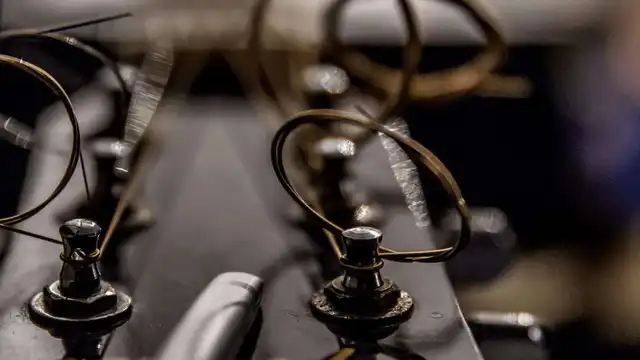5 Signs It's Time To Change Your Guitar Strings


1. Your guitar strings won't stay in tune
 Most of the time, tuning problems with guitar strings occur either with brand new strings, or old ones. When you first put on new strings you can fight the tuning problems by stretching the strings out a bit the first few times you play them. But once that period has passed, your guitar strings should stay in tune—until they don't.
If you've had the same strings on your guitar for more than a week or two, and you start to notice they don't hold tune as well as they did a few days beforehand, it might be time to change your strings.
Most of the time, tuning problems with guitar strings occur either with brand new strings, or old ones. When you first put on new strings you can fight the tuning problems by stretching the strings out a bit the first few times you play them. But once that period has passed, your guitar strings should stay in tune—until they don't.
If you've had the same strings on your guitar for more than a week or two, and you start to notice they don't hold tune as well as they did a few days beforehand, it might be time to change your strings.
2. Your guitar's tone is dull
 We all know the familiar snap of brand new strings. They're bright, present, and crisp. Some guitarists love the sound of fresh strings and change them every few days to keep it up. Other players like the more mellow tone of broken in strings and find the sweet spot to be between one and four weeks into the strings' life.
Regardless of your preference, your strings should never sound dull or flat, the way that really old strings can. If you're diming your amp's treble knob and you still sound like Wes Montgomery, it's time to change your guitar strings.
We all know the familiar snap of brand new strings. They're bright, present, and crisp. Some guitarists love the sound of fresh strings and change them every few days to keep it up. Other players like the more mellow tone of broken in strings and find the sweet spot to be between one and four weeks into the strings' life.
Regardless of your preference, your strings should never sound dull or flat, the way that really old strings can. If you're diming your amp's treble knob and you still sound like Wes Montgomery, it's time to change your guitar strings.
3. Your guitar strings are discolored
 When we play guitar, the oils from our fingers build up on the strings over time, leaving them more prone to corrosion, and eventually breakage.
An early sign that your strings are on their last legs is their color. As nickel and steel guitar strings age they lose their luster, turning a sort of dull gray color. Bronze acoustic strings lose their copper-colored sheen and turn a darker brown color. As soon as you start to see discoloration on your guitar strings, it's a good idea to slap on a new set.
When we play guitar, the oils from our fingers build up on the strings over time, leaving them more prone to corrosion, and eventually breakage.
An early sign that your strings are on their last legs is their color. As nickel and steel guitar strings age they lose their luster, turning a sort of dull gray color. Bronze acoustic strings lose their copper-colored sheen and turn a darker brown color. As soon as you start to see discoloration on your guitar strings, it's a good idea to slap on a new set.
4. Your guitar strings feel stiff
 Your guitar strings should always feel flexible and bendable (unless of course you're playing extra heavy strings without drop-tuning). Once they start to feel stiff, it means the metal is begin the process of corrosion.
Now this doesn't necessarily mean that your strings are going to break that day, but it does mean that your guitar isn't playing or sounding its best. At the very least, early signs of corrosion in your guitar strings should be a signal that it's time to order a spare set to keep around, just in case.
Your guitar strings should always feel flexible and bendable (unless of course you're playing extra heavy strings without drop-tuning). Once they start to feel stiff, it means the metal is begin the process of corrosion.
Now this doesn't necessarily mean that your strings are going to break that day, but it does mean that your guitar isn't playing or sounding its best. At the very least, early signs of corrosion in your guitar strings should be a signal that it's time to order a spare set to keep around, just in case.
5. Your guitar strings feel dirty
 Obviously this ties in with reason #3, but sometimes it's easier to feel your guitar strings' age than it is to see it. When you slide your fingers along your strings, they should feel smooth, almost slippery. If there's any friction between your fingers and the strings, it's likely a sign of dirt getting in the way.
Dirty strings not only sound duller than fresh strings, they also hamper your ability to move around the fretboard, making it less likely that you're playing your best.
If you're passionate about your playing and your tone, it's worth the extra couple of bucks a month to keep your guitar playing and sounding its best, and one of the easiest ways to do that is to stay on top of changing your guitar strings.
Obviously this ties in with reason #3, but sometimes it's easier to feel your guitar strings' age than it is to see it. When you slide your fingers along your strings, they should feel smooth, almost slippery. If there's any friction between your fingers and the strings, it's likely a sign of dirt getting in the way.
Dirty strings not only sound duller than fresh strings, they also hamper your ability to move around the fretboard, making it less likely that you're playing your best.
If you're passionate about your playing and your tone, it's worth the extra couple of bucks a month to keep your guitar playing and sounding its best, and one of the easiest ways to do that is to stay on top of changing your guitar strings.Other Posts you may like

Guitar Strings Order: How the Guitar is Tuned and Why

Best Acoustic Guitar Strings for Beginners

Two Handed Tapping: Our Top 8 Tappers of All Time

Which Guitar Strings Wear Your Fret Wire Down More?

What is Nashville Tuning? Its History, Best Guitar Strings & Uses

Guitar Scale Length Explained: String Tension & Playability
0 Responses
Leave a Reply
Your email address will not be published. Required fields are marked *




